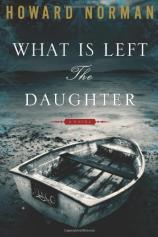What Is Left the Daughter
Review
What Is Left the Daughter
Though he teaches in the MFA program at the University of Maryland and lives in Vermont, in novels like THE BIRD ARTIST and THE MUSEUM GUARD, Howard Norman has succeeded in making the rugged coastal towns of Nova Scotia and the people who inhabit them his own. He continues that mastery with WHAT IS LEFT THE DAUGHTER, a thoughtful story of one man’s quiet triumph over adversity --- some self-inflicted and some cruelly thrust upon him.
Norman’s novel is structured as a single, long letter from Wyatt Hillyer to his daughter Marlais, written a quarter century after the events in the early 1940s that form the core of the story. Wyatt’s account opens with the double suicide of his parents, who leap from different Halifax bridges on the same evening, grief-stricken over their love for the same woman. Nearly 18, the orphaned young man moves to the town of Middle Economy, where he takes up residence with his Uncle Donald and Aunt Constance. Donald, a maker of sleds and toboggans to whom Wyatt is apprenticed, is obsessed with the activities of the German U-boats that prey upon civilian shipping off the Canadian Maritimes. He pins newspaper clippings about ship sinkings to the wall of his workshop and strains to hear static-filled news broadcasts. The obsession that places him “in the throes of a desperate imagination,” as he puts it, will bring about tragedy for the Hillyer family.
When Wyatt arrives at this new home, he meets Tilda, the adopted daughter of his aunt and uncle who seeks the odd career of “professional mourner.” His attraction to her is instantaneous, but she returns from a brief trip to Halifax with Hans Mohring, a German student of philosophy at the university there, with whom her relationship quickly deepens. Hans’ ancestry heightens the story’s tension, and when the ferry Caribou, carrying one of the novel’s principal characters, is torpedoed on its way from Halifax to Newfoundland, his presence precipitates a cataclysmic series of events that end with Wyatt convicted as an accessory to murder.
That shocking episode serves as the crucible in which Wyatt’s character is forged. What is most distinctive and rewarding about Norman’s novel is the placid, patient voice of his narrator recounting, without a trace of self-pity or self-justification and occasionally with dry humor, how he has absorbed the rough blows life has dealt him. From the bizarre death of his parents, to his unrequited love for Tilda, to his humble life as a “detritus gaffer” in Halifax harbor after the terrible crime that sunders the novel, he’s the victim of more than a lifetime’s worth of hardship.
Yet in the face of his travails, Wyatt perseveres, with regrets, certainly, but with an understanding that he has achieved the hard-won status of survivor. As Cornelia Tell, Wyatt’s friend and the owner of a bakery shop where many of the novel’s intimate conversations occur, reminds him, “In your life happiness is either cut to your length or it isn’t.” It’s a statement of homespun wisdom that sums up as well as any the outlook Wyatt has on his fate as he acknowledges to Cornelia in stark terms, “It’s how life’s turned out.”
As satisfying as is his depiction of Wyatt Hillyer’s life is the unerring sense of place that Norman brings to the story. In a recent interview, he explained his persistent fascination with Nova Scotia as a setting for his novels: “To me the Canadian Maritimes is a very compelling region; it's tragic, it's melancholy; it has a long history with the sea; it's elegiac. In the cemeteries, there are so many graves that are empty because the people were lost at sea. I'm comfortable with the disturbing paradoxes and haunting qualities of the area.”
Those characteristics all resonate in Norman’s painstaking recreation of the spartan but warmly human life of the province’s inhabitants --- the harsh climate and rugged landscape, the need to earn a living from the sea or other hard manual labor, the simple pleasures of a small town existence in a less complicated time. There’s a shared recognition that life is rarely, if ever, fair, but that even the characters not connected by blood are looking out for one another. With his latest novel, there’s no sense that Howard Norman has come close to exhausting the vein of stories Nova Scotia offers up to him.
Reviewed by Harvey Freedenberg on January 24, 2011
What Is Left the Daughter
- Publication Date: July 6, 2010
- Genres: Fiction
- Hardcover: 256 pages
- Publisher: Houghton Mifflin Harcourt
- ISBN-10: 0618735437
- ISBN-13: 9780618735433




